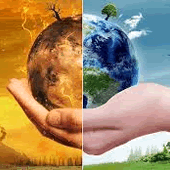
Below is a list of 50 common climate change and environment with short definitions. These terms cover cover a wide range of concepts related to climate change and the environment.
- Greenhouse Gases: Gases that trap heat in the atmosphere, contributing to global warming.
- Carbon Dioxide (CO2): A greenhouse gas produced by burning fossil fuels and deforestation.
- Methane (CH4): A potent greenhouse gas released from livestock and natural gas production.
- Global Warming: The increase in Earth’s average surface temperature due to rising greenhouse gas levels.
- Climate Change: Long-term changes in temperature, precipitation, and weather patterns on Earth.
- Renewable Energy: Energy from natural sources that are constantly replenished, like solar or wind power.
- Fossil Fuels: Non-renewable energy sources like coal, oil, and natural gas formed from ancient organic matter.
- Carbon Footprint: The total amount of greenhouse gases produced by human activities.
- Sustainability: Practices that meet current needs without compromising future generations’ ability to meet theirs.
- Biodiversity: The variety of life in a particular habitat or ecosystem.
- Deforestation: The large-scale removal of forests, often for agriculture or urban development.
- Afforestation: Planting trees in an area where there was no previous tree cover.
- Reforestation: Replanting trees in deforested areas.
- Ecosystem: A community of living organisms and their physical environment interacting as a system.
- Carbon Sequestration: The process of capturing and storing atmospheric CO2.
- Climate Policy: Regulations and initiatives aimed at mitigating climate change.
- Sustainable Development: Economic development that is conducted without depletion of natural resources.
- Conservation: The protection and preservation of natural environments and wildlife.
- Ecology: The study of interactions between organisms and their environment.
- Endangered Species: Species at risk of extinction due to habitat loss, poaching, or other factors.
- Habitat: The natural environment in which a species lives.
- Pollution: The introduction of harmful substances or products into the environment.
- Ozone Layer: A layer in Earth’s stratosphere that absorbs most of the Sun’s ultraviolet radiation.
- Acid Rain: Precipitation that contains acidic components, harming ecosystems and buildings.
- Global Warming Potential (GWP): A measure of how much heat a greenhouse gas traps in the atmosphere.
- Carbon Neutral: Having a net zero carbon footprint by balancing emissions with carbon removal or offsets.
- Carbon Offset: A reduction in emissions to compensate for emissions produced elsewhere.
- Climate Mitigation: Efforts to reduce or prevent the emission of greenhouse gases.
- Climate Adaptation: Adjusting practices, processes, and structures to minimize damage caused by climate change.
- Renewable Resources: Natural resources that can be replenished naturally with the passage of time.
- Non-Renewable Resources: Resources that cannot be readily replaced by natural means.
- Zero Waste: The conservation of all resources by means of responsible production, consumption, reuse, and recovery.
- Biodegradable: Capable of being decomposed by bacteria or other living organisms.
- E-waste: Discarded electronic appliances such as mobile phones, computers, and televisions.
- Compost: Decomposed organic material used as a fertilizer for plants.
- Overfishing: Harvesting fish from the sea at rates too high for species to replace themselves.
- Ocean Acidification: The ongoing decrease in pH of the Earth’s oceans caused by the uptake of CO2 from the atmosphere.
- Climate Resilience: The ability of a system to withstand and recover from climate impacts.
- Green Economy: An economy that aims for sustainable development without degrading the environment.
- Green Infrastructure: Infrastructure that uses natural processes to deliver environmental benefits, such as green roofs or rain gardens.
- Urbanization: The process of making an area more urban, often leading to habitat destruction.
- Desertification: The process by which fertile land becomes desert, typically as a result of drought or deforestation.
- Sustainable Agriculture: Farming practices that protect the environment, public health, and animal welfare.
- Green Building: Designing and constructing buildings in an environmentally responsible and resource-efficient manner.
- Climate Refugees: People forced to leave their homes due to adverse climate conditions.
- Microplastics: Tiny plastic particles that pollute the environment and harm wildlife.
- Carbon Pricing: Charging emitters of CO2 for their emissions to incentivize reductions.
- Permaculture: The development of agricultural ecosystems intended to be sustainable and self-sufficient.
- Watershed: An area of land that drains all the streams and rainfall to a common outlet.
- Ecological Footprint: A measure of human impact on Earth’s ecosystems, typically expressed in the amount of natural resources consumed.
